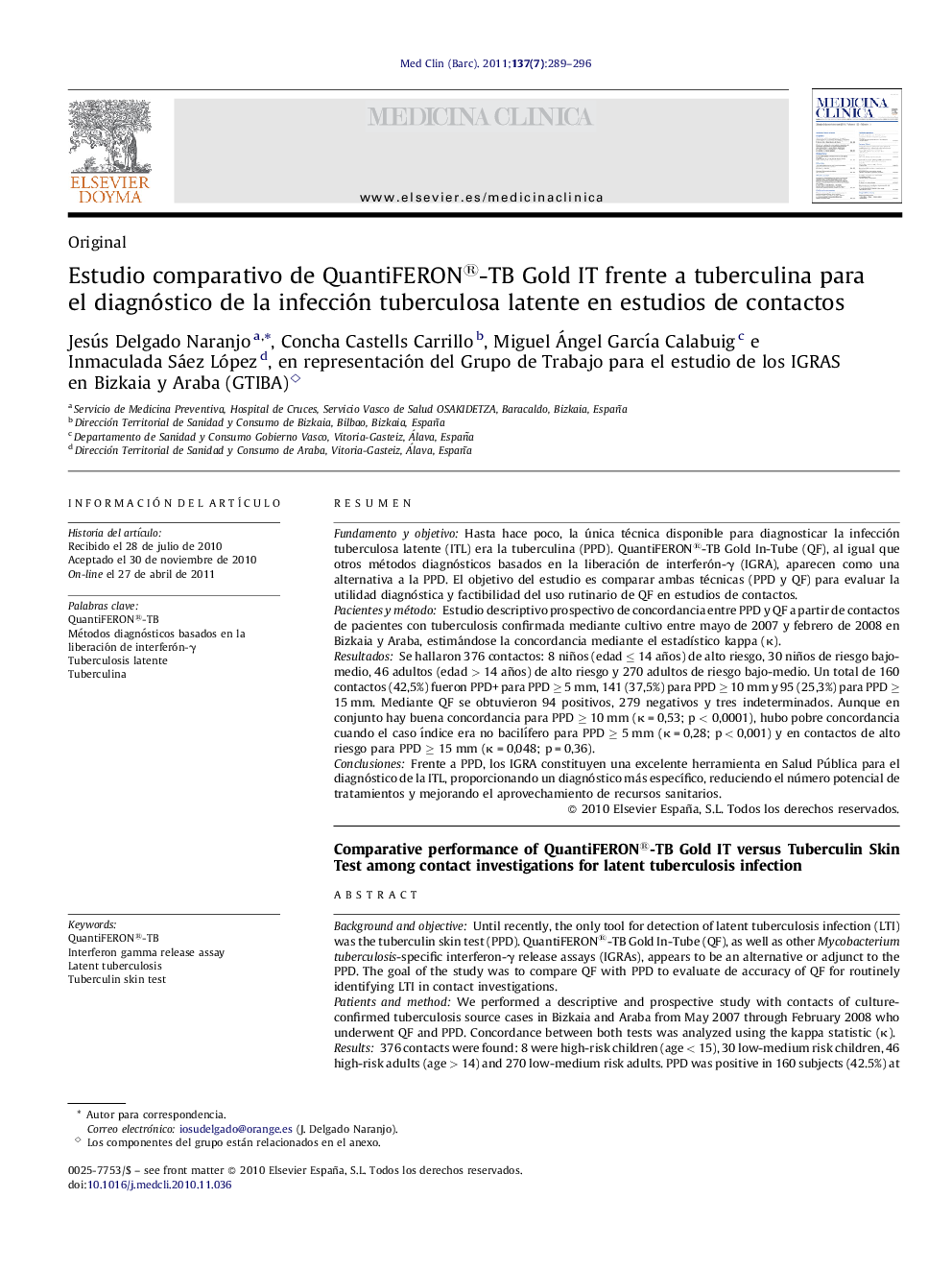| Article ID | Journal | Published Year | Pages | File Type |
|---|---|---|---|---|
| 3798443 | Medicina Clínica | 2011 | 8 Pages |
ResumenFundamento y objetivoHasta hace poco, la única técnica disponible para diagnosticar la infección tuberculosa latente (ITL) era la tuberculina (PPD). QuantiFERON®-TB Gold In-Tube (QF), al igual que otros métodos diagnósticos basados en la liberación de interferón-γ (IGRA), aparecen como una alternativa a la PPD. El objetivo del estudio es comparar ambas técnicas (PPD y QF) para evaluar la utilidad diagnóstica y factibilidad del uso rutinario de QF en estudios de contactos.Pacientes y métodoEstudio descriptivo prospectivo de concordancia entre PPD y QF a partir de contactos de pacientes con tuberculosis confirmada mediante cultivo entre mayo de 2007 y febrero de 2008 en Bizkaia y Araba, estimándose la concordancia mediante el estadístico kappa (κ).ResultadosSe hallaron 376 contactos: 8 niños (edad ≤ 14 años) de alto riesgo, 30 niños de riesgo bajo-medio, 46 adultos (edad > 14 años) de alto riesgo y 270 adultos de riesgo bajo-medio. Un total de 160 contactos (42,5%) fueron PPD+ para PPD ≥ 5 mm, 141 (37,5%) para PPD ≥ 10 mm y 95 (25,3%) para PPD ≥ 15 mm. Mediante QF se obtuvieron 94 positivos, 279 negativos y tres indeterminados. Aunque en conjunto hay buena concordancia para PPD ≥ 10 mm (κ = 0,53; p < 0,0001), hubo pobre concordancia cuando el caso índice era no bacilífero para PPD ≥ 5 mm (κ = 0,28; p < 0,001) y en contactos de alto riesgo para PPD ≥ 15 mm (κ = 0,048; p = 0,36).ConclusionesFrente a PPD, los IGRA constituyen una excelente herramienta en Salud Pública para el diagnóstico de la ITL, proporcionando un diagnóstico más específico, reduciendo el número potencial de tratamientos y mejorando el aprovechamiento de recursos sanitarios.
Background and objectiveUntil recently, the only tool for detection of latent tuberculosis infection (LTI) was the tuberculin skin test (PPD). QuantiFERON®-TB Gold In-Tube (QF), as well as other Mycobacterium tuberculosis-specific interferon-γ release assays (IGRAs), appears to be an alternative or adjunct to the PPD. The goal of the study was to compare QF with PPD to evaluate de accuracy of QF for routinely identifying LTI in contact investigations.Patients and methodWe performed a descriptive and prospective study with contacts of culture-confirmed tuberculosis source cases in Bizkaia and Araba from May 2007 through February 2008 who underwent QF and PPD. Concordance between both tests was analyzed using the kappa statistic (κ).Results376 contacts were found: 8 were high-risk children (age < 15), 30 low-medium risk children, 46 high-risk adults (age > 14) and 270 low-medium risk adults. PPD was positive in 160 subjects (42.5%) at PPD ≥ 5 mm, 141 (37.5%) at PPD ≥ 10 mm and 95 (25.3%) at PPD ≥ 15 mm. In QF analysis 94 subjects were positive, 279 negative and 3 indeterminate. Overall agreement between QF and PPD was good at PPD ≥ 10 mm (κ = 0.53; p < 0.0001) but agreement was poor when the index case had positive baciloscopy at PPD ≥ 5 mm (κ = 0.28; p < 0.001) and high-risk contacts at PPD ≥ 15 mm (κ = 0.048; p = 0.36).ConclusionsIGRAs are an accurate indicator of LTI, providing a more specific way of diagnostic and reducing the number of subjects to be treated. QF appears to be a valuable public health tool with potential advantages over the PPD and improving resources.
